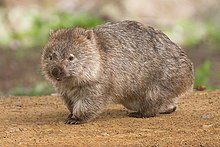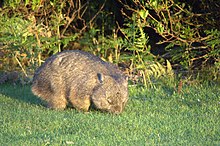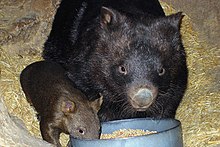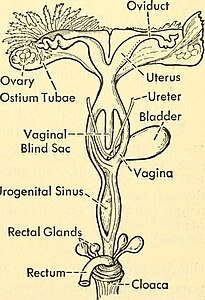Wombat
| Wombat[1] Temporal range:
| |
|---|---|

| |
| Common wombat Maria Island, Tasmania | |
| Scientific classification | |
| Domain: | Eukaryota |
| Kingdom: | Animalia |
| Phylum: | Chordata |
| Class: | Mammalia |
| Infraclass: | Marsupialia |
| Order: | Diprotodontia |
| Superfamily: | Vombatoidea
|
| Family: | Vombatidae Burnett, 1830 |
| Type genus | |
| Vombatus Geoffroy, 1803
| |
| Genera and species | |
| |
Wombats are short-legged, muscular
Etymology
The name "wombat" comes from the now nearly extinct
Evolution and taxonomy
Though genetic studies of the Vombatidae have been undertaken, evolution of the family is not well understood. Wombats are estimated to have diverged from other Australian marsupials relatively early, as long as 40 million years ago, while some estimates place divergence at around 25 million years.[6]: 10– Some prehistoric wombat genera greatly exceeded modern wombats in size. The largest known wombat, Phascolonus, which went extinct approximately 40,000 years ago,[7] is estimated to have had a body mass of up to 360 kilograms (790 lb).[8]
Characteristics

Wombats dig extensive burrow systems with their rodent-like front teeth and powerful claws. One distinctive adaptation of wombats is their backward pouch. The advantage of a backward-facing pouch is that when digging, the wombat does not gather soil in its pouch over its young. Although mainly
Wombats leave distinctive cubic feces.[9] As wombats arrange these feces to mark territories and attract mates, it is believed that the cubic shape makes them more stackable and less likely to roll, which gives this shape a biological advantage. The method by which the wombat produces them is not well understood, but it is believed that the wombat intestine stretches preferentially at the walls, with two flexible and two stiff areas around its intestines.[10] The adult wombat produces between 80 and 100, 2 cm (0.8 in) pieces of feces in a single night, and four to eight pieces each bowel movement.[11][12] In 2019 the production of cube-shaped wombat feces was the subject of the Ig Nobel Prize for Physics, won by Patricia Yang and David Hu.[13]

All wombat teeth lack roots and are ever-growing, like the incisors of rodents.
Wombats' fur can vary from a sandy colour to brown, or from grey to black. All three known extant species average around 1 metre (3 ft 3 in) in length and weigh between 20 and 35 kg (44 and 77 lb).
Female wombats give birth to a single young after a gestation period of roughly 20–30 days, which varies between species.[15][16] All species have well-developed pouches, which the young leave after about six to seven months. Wombats are weaned after 15 months, and are sexually mature at 18 months.[17]
A group of wombats is known as a wisdom,[18][19] a mob, or a colony.[20]
Wombats typically live up to 15 years in the wild, but can live past 20 and even 30 years in captivity.[21][22] The longest-lived captive wombat lived to 34 years of age.[22]
In 2020, biologists discovered that wombats, like many other Australian marsupials, display bio-fluorescence under ultraviolet light.[23][24][25]
-
Dentition, as illustrated in Knight's Sketches in Natural History
-
Wombat skeleton
-
Female reproductive tract
Ecology and behaviour

Wombats have an extraordinarily slow metabolism, taking around 8 to 14 days to complete digestion, which aids their survival in arid conditions.[17] They generally move slowly.[26] Wombats defend home territories centred on their burrows, and they react aggressively to intruders. The common wombat occupies a range of up to 23 ha (57 acres), while the hairy-nosed species have much smaller ranges, of no more than 4 ha (10 acres).[17]
Wombats are generally quiet animals. Bare-nosed wombats can make a number of different sounds, more than the hairy-nosed wombats. Wombats tend to be more vocal during mating season. When angered, they can make hissing sounds. Their call sounds somewhat like a pig's squeal. They can also make grunting noises, a low growl, a hoarse cough, and a clicking noise.[29]
Species
The three extant species of wombat[1] are all endemic to Australia and a few offshore islands. They are protected under Australian law.[30]
- Common wombat (Vombatus ursinus)
- Northern hairy-nosed wombat or yaminon (Lasiorhinus krefftii)[31]
- Southern hairy-nosed wombat (Lasiorhinus latifrons)
Human relations
History
Depictions of the animals in

After the ship
Wombats were classified as vermin in 1906, and a bounty was introduced in 1925.[6]: 103 This and the removal of a substantial amount of habitat have greatly reduced their numbers and range [38].
Attacks on humans
Humans can receive puncture wounds from wombat claws, as well as bites. Startled wombats can also charge humans and bowl them over,[39] with the attendant risks of broken bones from the fall. One naturalist, Harry Frauca, once received a bite 2 cm (0.8 in) deep into the flesh of his leg—through a rubber boot, trousers and thick woollen socks.[40] A UK newspaper, The Independent, reported that on 6 April 2010, a 59-year-old man from rural Victoria state was mauled by a wombat (thought to have been angered by mange),[41] causing a number of cuts and bite marks requiring hospital treatment. He resorted to killing it with an axe.[42]
Cultural significance



Common wombats are considered by some farmers as a nuisance due primarily to their burrowing behaviour. "Fatso the Fat-Arsed Wombat" was the tongue-in-cheek "unofficial" mascot of the 2000 Sydney Olympics. Since 2005, an unofficial holiday called Wombat Day has been observed on 22 October.[43]
Wombat meat has been a source of bush food from the arrival of aboriginal Australians to the arrival of Europeans. Due to the protection of the species, wombat meat as food is no longer part of mainstream Australian cuisine, but wombat stew was once one of the few truly Australian dishes.[44] In the 20th century, the more easily found rabbit meat was more commonly used. (Rabbits are now considered an invasive pest in Australia.) The name of the dish is also used by a popular children's book and musical.[45]
Wombats have featured in Australian postage stamps and coins. The hairy-nosed wombats have featured mainly to highlight their elevated conservation status. The northern hairy-nosed wombat featured on an Australian 1974 20-cent stamp and also an Australian 1981 five-cent stamp. The common wombat has appeared on a 1987 37-cent stamp and an Australian 1996 95-cent stamp. The 2006 Australian Bush Babies stamp series features an AU$1.75-stamp of a baby common wombat, and the 2010 Rescue to Release series features a 60-cent stamp of a common wombat being treated by a veterinarian. Wombats are rarely seen on circulated Australian coins, an exception is a 50-cent coin which also shows a
Many places in Australia have been named after the wombat, including a large number of places where they are now locally extinct in the wild. References to the locally extinct common wombat can be found in parts of the Central Highlands of Victoria, for example the
Wombats have also been a feature of Australian television. While wombats are not generally kept as pets, a notable depiction of a common wombat as a pet is Fatso from the Australian television show A Country Practice. The Brisbane television show Wombat was also named for the animals.
Australian literature contains many references to the wombat. Examples are Mr. Walter Wombat from the adventures of Blinky Bill and one of the main antagonists in The Magic Pudding by Norman Lindsay.
Conservation
All species of wombats are protected in every Australian state.[47]
The northern hairy-nosed wombat is an endangered species.[48] The biggest threats the species faces are its small population size, predation by wild dogs, competition for food because of overgrazing by cattle and sheep, and disease.[48][49]
The only known wild populations of this species exist in two locations in Queensland, the Epping Forest National Park, and a smaller colony being established by translocating wombats to the Richard Underwood Nature Refuge at Yarran Downs.[48] This second colony is being created through the Xstrata reintroduction project, which is being funded by Xstrata, a Swiss global mining company.[50]
The wombat population in the Epping Forest National Park has been increasing since a predator-proof fence was erected in the park.[48] According to the latest census, taken in 2013, the park is home to 196 of these endangered wombats, with numbers at the two locations expected to have increased to 230 by late 2015.[48]
Despite its name, the common wombat is no longer as common as it once was, and is under significant threat [51][52]. However, in eastern Victoria, they are not protected, and they are considered by some to be pests, especially due to the damage they cause to rabbit-proof fences.[48][53] Opportunistic research studies have been conducted on the immune system of common wombats, which could be used as a tool for future conservation efforts.[54]
WomSAT, a citizen science project, was established in 2016 to record sightings of wombats across the country.[55][56][57] The website and mobile phone app can be used to log sightings of live or deceased wombats and wombat burrows. Since its establishment the project has recorded over 23,000 sightings across New South Wales, Victoria, Tasmania and South Australia.[58][59] More recently, the citizen science project has published findings on wombat roadkill[60] and sarcoptic mange incidence[61] across Australia.
References
- ^ OCLC 62265494.
- ^ "Northern Hairy-nosed Wombat". Department of Sustainability, Environment, Water, Population and Communities. Australian Government. Retrieved 2 July 2011.
- ^ ISBN 978-1-921799-10-5.
- ^ Reed, Alexander Wyclif (1969). Place-names of New South Wales, their origins and meanings. Reed. p. 152.
- ^ "Common Wombat". Lady Wild Life. Archived from the original on 25 July 2008. Retrieved 1 September 2008.
- ^ ISBN 978-0-643-09986-9.
- PMID 32418985.
- S2CID 254622473.
- ^ Sample, Ian (19 November 2018). "Scientists unravel secret of cube-shaped wombat faeces". The Guardian. Retrieved 19 November 2018.
- ISSN 0261-3077. Retrieved 31 January 2021.
- ^ Dvorsky, George (18 November 2018). "We Finally Know How Wombats Produce Their Distinctly Cube-Shaped Poop". Gizmodo. Archived from the original on 19 November 2018. Retrieved 19 November 2018.
- ^ "Mystery solved: this is how wombats do cube-shaped poo". Australian Geographic. 28 November 2018.
- ^ "The Ig Nobel Prize Winners". improbable.com. Improbable Research. August 2006. Retrieved 20 April 2020.
- .
- ^ Green, E; Myers, P (2006). "Lasiorhinus latifrons". Animal Diversity Web. University of Michigan Museum of Zoology. Retrieved 13 August 2010.
- ^ Watson, A (1999). "Vombatus ursinus". Animal Diversity Web. University of Michigan Museum of Zoology. Retrieved 13 August 2010.
- ^ ISBN 978-0-87196-871-5.
- ^ Britton, Ben. "Wombat". Animal Encounters. NatGeo Wild.
- ISBN 978-1-4521-2952-5
- ^ "Common wombat". National Geographic. 11 April 2010. Archived from the original on 9 March 2021. Retrieved 7 February 2023.
- ^ "Wombat". animals.sandiegozoo.org. Retrieved 7 February 2023.
- ^ a b "Common Wombat". Ballarat Wildlife Park. Retrieved 7 February 2023.
- ^ "'The platypuses were glowing': The secret light of Australia's marsupials". www.theguardian.com. 18 December 2020. Retrieved 29 December 2020.
- ^ "Scientists accidentally discover Australian marsupials glow in the dark". www.cnet.com. Retrieved 29 December 2020.
- ^ Giaimo, Cara (18 December 2020). "More Mammals Are Hiding Their Secret Glow". The New York Times. Retrieved 29 December 2020.
- ^ Marinacci, Peter. "Wombat Behavior". Wombania's Wombat Information Center. Retrieved 24 September 2020.
Wombats walk with a somewhat awkward, shuffling or waddling gait.
- Tasmanian Government. Retrieved 13 August 2010.
- ISSN 0261-3077. Retrieved 30 September 2023.
- ^ Marinacci, Peter. "Wombat Vocalizations". Wombania's Wombat Information Center. Retrieved 24 September 2020.
- ^ Humble, Gary (1 June 2006). "The Uncommon Wombat". Scribbly Gum. Australian Broadcasting Corporation. Retrieved 13 August 2010.
- Australian Government. 12 February 2010. Retrieved 13 August 2010.
- ^ Totaro, Paola (2 July 2003). "Rock art find makes Stonehenge seem recent". Sydney Morning Herald.
- ISBN 978-1-921834-90-5.
- ^ ISBN 978-0-644-06056-1. Retrieved 30 December 2009.
- ^ Simpson, J. (16 January 2009). "The 'wombat' trail – David Nash". Transient Languages & Cultures. The University of Sydney. Archived from the original on 6 January 2010. Retrieved 30 December 2009.
- ^ Nash, M. "Maritime Archaeology Monograph and Reports Series No.2 – Investigation of a Survivors Camp from the Sydney Cove Shipwreck Archived 3 March 2016 at the Wayback Machine." Master of Maritime Archaeology Thesis. Department of Archaeology, Flinders University, South Australia. 2004. Accessed 30 December 2009.
- ^ Moore-Robinson, J. (1911). A Record of Tasmanian nomenclature, with dates and origins (PDF). The Mercury Printing Office – Hobart, Tasmania. p. 28. Retrieved 30 December 2009.
- doi:10.1071/AM19035.
- ^ Robinson, Georgina (7 April 2010). "Wombat combat: danger is their middle name". The Examiner. Retrieved 13 August 2010.
- ISBN 978-0864380180.)
{{cite book}}: CS1 maint: location missing publisher (link - ^ "Wombat bites Australian bush fire survivor". BBC News. 6 April 2010. Retrieved 9 April 2010.
- ^ "Australian Man Mauled in Rare Attack". The Independent. Reuters. 7 April 2010. Retrieved 7 April 2010.
- ^ Middleton, Amy (22 October 2009). "The day of the wombat". Australian Geographic. Archived from the original on 30 September 2013. Retrieved 13 August 2010.
- ^ 'International Recipes from Balmain'. The Canberra Times. Monday 19 December 1977. pg 10
- ^ Bishop, Rita. "Wombat Stew by Marcia K Vaughan: Teaching Notes" (PDF).
- ^ "Ten Dollar". Blue Sheet Coin Values. Retrieved 19 March 2017.
- ^ "Wombats now protected all over Victoria after outrage over hunting lodge". 6 February 2020.
- ^ a b c d e f "Northern hairy-nosed wombat, Lasorhinus krefftii". Queensland Government. 23 October 2015. Retrieved 19 March 2017.
- ^ Willis, Paul (7 March 2003). "Northern Hairy Nosed Wombat". ABC Television, Catalyst. Retrieved 8 February 2012.
- ^ Todd Woody (12 March 2009). "Wombat Love". Time. Archived from the original on 16 March 2009. Retrieved 22 April 2011.
- doi:10.1071/AM19015.
- .
- ^ "Wombat, Vombatus ursinus". Parks & Wildlife Service, Tasmania. 21 May 2012. Archived from the original on 27 April 2013. Retrieved 23 January 2015.
- S2CID 202014972.
- ^ "WomSAT". FeralScan.
- ^ "Mangy marsupials: wombats are catching a deadly disease, and we urgently need a plan to help them". The Conversation. 2015.
- doi:10.1071/AM18018.
- ^ "WomSAT". FeralScan.
- ^ "2 biggest threats to wombats revealed in new data gathered by citizen scientists". The Conversation. 2023.
- doi:10.1071/AM22001.
- PMID 37865949.
Further reading
- Wombats, Barbara Triggs, Houghton Mifflin Australia Pty, 1990, ISBN 0-86770-114-5. Facts and photographs of wombats for children.
- The Wombat: Common Wombats in Australia, Barbara Triggs, University of New South Wales Press, 1996, ISBN 0-86840-263-X.
- The Secret Life of Wombats, James Woodford, Text Publishing, 2002, ISBN 1-877008-43-5.
- How to Attract the Wombat, Will Cuppy with illustrations by Ed Nofziger, David R. Godiine, 2002, ISBN 1-56792-156-6(Originally published 1949, Rhinehart)
- The Secret World of Wombats, Jackie French with illustrations by Bruce Whatley, Harper Collins Publishers, 2005, ISBN 0-207-20031-9.
- Christmas Wombat, Jackie French with illustrations by Bruce Whatley, Clarion Books, 2012, ISBN 978-0547868721.
External links
- South Australian Government Faunal Emblem (official website)
- Rossetti's Wombat: A Pre-Raphaelite Obsession in Victorian England Archived 5 June 2022 at the Wayback Machine
- Sydney Morning Herald: Man attacked by wombat
- Secret sex life of wombat
- Video of the most long-lived known captive wombat, Patrick
- Video of Christmas Wombat
- We need to have a conversation about wombats (The Oatmeal)



